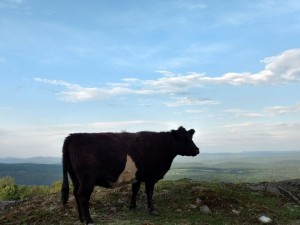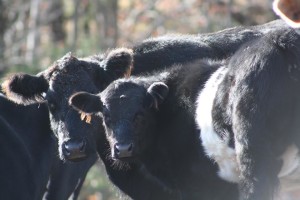One day, the cow now called Jan made a fateful leap over a fence and into what must have felt like another world. Over on Facebook, many people have been moved by a post in which Cheryl wonders what Jan might be thinking in this photo, so it seems to be a good time to tell Jan’s story and see what we can learn from it.
As it happens, Jan plays a prominent role in the contribution of VINE co-founder pattrice jones to a recent anthology concerning animals and capitalism. Here’s how pattrice introduces Jan in that chapter:
One day, a cow jumped over a beef farm fence to birth a calf in the forest, far from the grasping hands of humans. She and her son then found their way to a friendly person who conveyed them to a sanctuary. The mother’s fierceness in protecting her son from perceived threats made them a poor match for a sanctuary offering tours to the public, and so they both came to VINE Sanctuary, where they eventually joined the hardy herd in our back pasture. The cows in that community organize their own affairs as they see fit. They often choose to sleep in the forest rather than in the barn and to drink from a brook or pond rather than water troughs. Other than eyeballing everybody twice each day, just to ensure that nobody is ill or injured in any way, sanctuary staff stay out of the way.
Jan and her calf Justin have flourished in that setting. As Justin has grown up into a sweet-tempered young adult with a fondness for bird-watching, Jan has made friends with cows her own age. She no longer glares and prepares to charge any person who might dare to look too lingeringly at her son, but she still becomes visibly wary when strangers appear.
I’ve endured more than a few uncomfortable moments under the searchlight of Jan’s gaze, hoping she will see that she need not charge at me to protect herself or her son. At such moments, it seems to me that Jan is both mad and mystified, angered and confused by what she has seen people do to cows. In Jan’s expression when she looks at people, even when she is comparatively relaxed, I perceive a combination of challenge and question, as if she is prepared to fight an enemy she cannot fathom.
In the months since that was written, Jan has continued to develop relationships within the community of cows in the back pasture. Her son Justin has reached adulthood himself and now stands taller than his mother. He looks out for her as often as she looks out for him.
Here are some things we can learn from Jan:
- Animals are active seekers of their own liberation.
- Animals are individuals with their own personalities and projects.
- Animals are not objects to by judged by their looks.
- Adult animals are… adults.
Let’s take them one at a time.
Animals are Active.
Every day, in a multiplicity of ways, nonhuman animals resist their oppression and exploitation by humans. They fight back. They run away. They disregard human-constructed borders, and they have not ceded to human beings the right to make the rules. Considered property themselves, they literally trample all over our so-called “property rights” whenever they get the opportunity.
Therefore we should recognize animals as the true leaders of the animal liberation movement, seeing ourselves as their allies rather than their heroes. This is important for two reasons: First, as the late ecofeminist scholar and activist Marti Kheel argued, the “heroic ethic” in which people “save the planet” reproduces the very human-centered way of thinking that menaces the planet and our fellow inhabitants. Next, if we think of ourselves as the center of the animal liberation movement, we might forget to ask ourselves what animals themselves might want us to do or not do.
Animals are Individuals
Fierce and serious Jan is very different than her sometimes playful bird-watching son and different again from her friends Princess and Luna. Like many groups of friends, Jan, Luna, and Princess do share some characteristics, such as being strong-willed and liking to spend quiet time by themselves in the woods. In the latter they are different from their more gregarious herd-mates Maizey and Poncho, who are also strong-willed but are more high-spirited and sociable. Noticing these differences in personality helps us remember not to stereotype animals or project our ideas onto them. We hope that makes us less likely to make any assumptions about animals (or what they might want) without paying close attention to what they might be telling us.
Animals are not Objects
While Jan does seem to worry about what people might do, Jan doesn’t care at all what people think about her looks. Like girls and women in a sexist society, who are often treated as if their worth is determined by whether or not they are considered attractive by boys and men, animals in our speciesist society often are reduced to their physical appearance. Put on display at dog shows and “livestock” fairs, many nonhuman animals are literally judged by their looks. Even vegans sometimes do this. Again and again on Facebook, we have posted a photo of a sanctuary resident along with a caption concerning their personality, history, or role in our multi-species community only to get a stream of comments like “handsome boy!” and “beautiful girl!” That brings us to another thing we can learn from Jan’s story…
Adult Animals are… Adults
When sanctuary co-founders Miriam Jones and pattrice jones first began to do animal advocacy work, they looked to established sanctuaries for advice. When advised by Karen Davis at United Poultry Concerns to avoid referring to adult animals with juvenile terms such as “boy” or “girl,” that made perfect sense to them. Treating adults as if they were minors is one way that human beings signal disrespect. Thus, it has always been our organizational policy to demonstrate respect for adult animals by not talking about them as if they were “babies.”
Because that early advice did seem so basic and sensible, we’ve been surprised by how much push-back we’ve gotten about this over the years. Even animal advocates sometimes bristle when asked to rethink the habit of referring to adult animals as “babies.” We’re so used to referring to beloved animals as if they were juveniles, even when they are the equivalent of our elders. It’s so easy to slip up and do this! But, besides being accidentally disrespectful, this may make us more likely to think of animals as passive objects for whom we can be heroes and therefore disregard their opinions when deciding what to do on their behalf. Here at VINE, Jan helps remind us not to do that.






Powerful writing. Thank you.